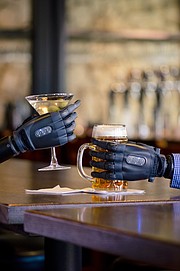When the first waterproof prosthetic hand hit the market, a family-owned, Chattanooga-based prosthetic manufacturer with more than 100 years of history became its exclusive U.S. distributor.
"It just took off. It blew all of our estimations away," says Scott Hosie, director of clinical education at Fillauer Motion Control, Inc., which manufactures and sells prosthetic and orthotic devices.
The TASKA hand is designed and manufactured in New Zealand, and it only took three months to sell the entire first batch, he says.
"TASKA was scrambling for that first year to get production geared up," Hosie adds.
The hand being waterproof was important at the start of design several years ago, but is now is critical with COVID-19, he says.
"You've got to be able to wash your hand," Hosie says. "To be able to just stick it in the sink and wash it with your other hand is important."
In addition to being waterproof, the prosthetic hand is triggered by physical movement. Electrodes in the socket connected to a user's arm recognize "really minute electrical impulses that muscles give off," Hosie explains.
The hand can hold a can without spilling the contents; it can pick up small objects such as a pencil; it can hold an egg without breaking it; it can use a knife or start a weed wacker.
Gerry Kinney, 57, who lost his forearms in an electrical accident in 2015, says he's used other prosthetic hands, but none come close to the TASKA.
"I love holding my wife's hand and especially my 3-year-old granddaughter's hand," says Kinney, who lives in Southern Illinois.
After 18 years as an electric lineman, Kinney accidentally came into contact with a 7,200-volt power line.
"It entered the index finger on my right hand, crossed my chest and exited the small finger on my left hand. I'm blessed to be alive," he says.
While doctors agreed that he was lucky, they had to amputate both of his arms below the elbows. A little over two years ago, he learned about the TASKA hand.
Snapping into a socket that attaches to the wrist or, in Kinney's case, prosthetic forearms, the hands have buttons on the back that generate 23 specific grips.
"I love it when using hand tools, especially power tools with triggers," Kinney says. "I love it for driving."
The buttons make the grips easy to use, and sophisticated electronics in the socket can also identify which muscles are producing the electric impulses and move the fingers into the grip produced by those muscles.
"The patient can access all those different grip patterns just by different muscle signals," Hosie says.
Though it may sound like science-fiction, after a period of learning, the hand can almost start thinking for itself, Hosie says.
"It can look at a whole bunch of muscles and it can decide, 'OK, if I see a pattern like this, I'm going to open the hand. If I see a pattern of muscles like this, I can rotate the wrist,'" Hosie explains.
Even farther along the sci-fi spectrum, operations of the hand are a type of mind control, he says.
"It is in a way that the patient thinks, 'OK, I'm going to fire this muscle,' and then the system can pick up that impulse," Hosie says. "It's real natural. Yes, it's mind control with that extra step of the muscle in between."
With the abilities his hands give him, Kinney teaches safety measures to other electric linemen and to students at a college near his home.
"The TASKA hand allows me to actually show them how to hold the tools they will be using in the field," he says. "Most importantly the TASKA hand allows me to stay in an industry that I love, be it in another form."

